How to apply liquid wallpaper to the wall?
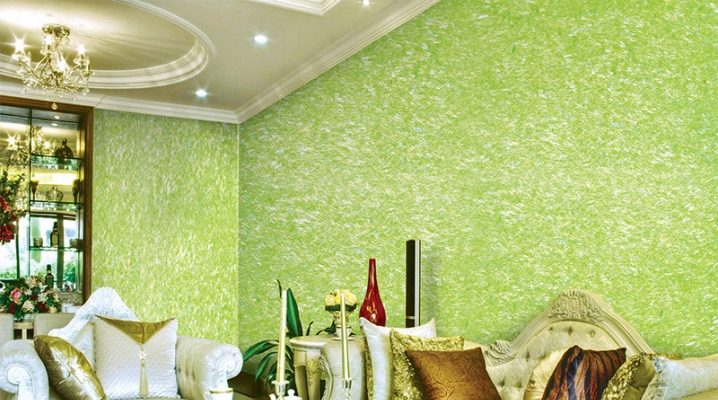
Wall cladding with unusual material allows you to create a special atmosphere at home. Among the wide range of wall coverings presented by trademarks for sale, liquid wallpaper is a particularly interesting type of decoration. Differing from roll-up counterparts with a clearly fixed shape, they have a unique structure and features of pasting. To understand how to apply liquid wallpaper on the wall, you need to know what it is, what are the features of the material, what are the advantages and how dangerous are their disadvantages.
What it is?
Liquid wallpaper is a new generation coating in the form of powder or ready-made wet mix, intended for interior wall decoration. In fact, this is wet wallpaper that is spread on the wall using special tools. The material combines the best qualities of paper wallpaper, paint and varnish coatings and decorative plaster. Today it is used for wall cladding of residential and non-residential premises. The texture of liquid wallpaper differs from all existing varieties of wallpaper and has a unique effect due to special additives.
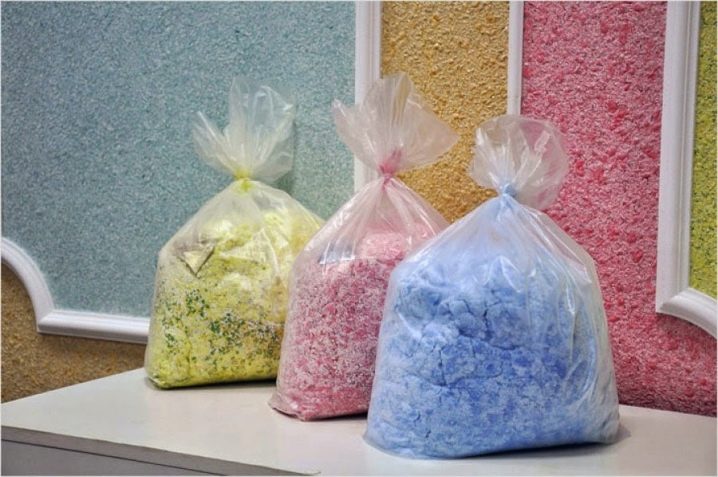
Liquid wallpaper is not decorative plaster: it is a completely different material, based on no sand. This product includes:
- cotton;
- cellulose;
- polyester;
- silk fiber;
- dyes and fillers;
- adhesive substance.
Due to the presence of silk fibers in the composition, the wall decoration seems to be textile. Additional additives (marble chips, colored flock, mica shine, mother-of-pearl) make the surface of the wallpaper unique.
Liquid wallpaper looks like small sawdust, it is initially impregnated with an adhesive solution. The features of the material are characterized by strong and weak properties.
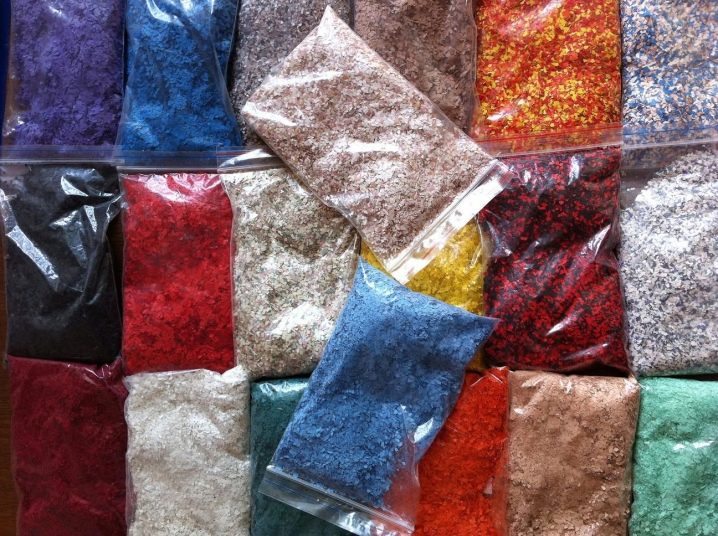
Advantages
Liquid wallpaper is a unique wall decoration that has a number of advantages. She:
- stands out favorably against the background of any analogues with an unusual look, drawing attention to itself;
- regardless of the pattern, color and type of raw materials decorates the walls, making the interior complete, and the room - homely cozy;
- allows you to manually create a special mood of space by combining shades or performing a drawing, without restricting the master in choosing a theme, placement and size of the picture;
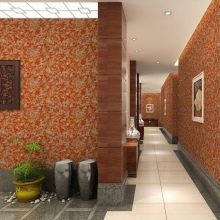
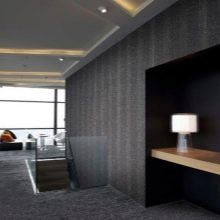
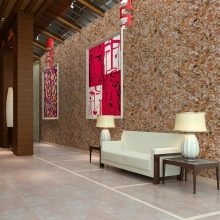
- is a good soundproofing of walls, relieving households from annoying extraneous noise from neighboring apartments;
- is thermal insulation: walls with such a finish become warmer, which is noticeable in the cold season;
- perfectly masks and evens out uneven walls with an even distribution of mass on the surface;
- does not roll off the vertical surface of the walls during application, does not complicate the cladding, does not crumble;
- is an environmentally friendly finishing product: it does not have harmful toxic components in the composition and does not have a pungent odor;
- provides for easy and quick restoration of the surface of damaged areas of the coating (especially important if there are small children or pets in the house);
- resistant to temperature extremes, does not lag behind the surface of the walls, does not fade, is durable (it gets bored faster than it becomes unusable);
- fireproof, non-flammable, has excellent antistatic and dust-repellent properties;
- does not require cladding skills: easy to apply and provides for reapplication (removal from walls, dilution with water and reapplication on walls).
This finish is suitable for cladding different dwelling rooms, and it can also be used for the ceiling. It looks beautiful in the bedroom, is appropriate in the children's room, harmonious in the living room, home library, study, corridor.
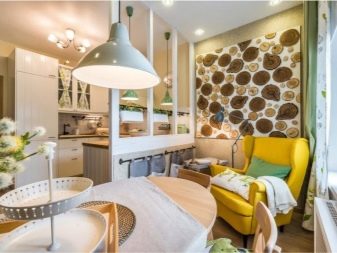
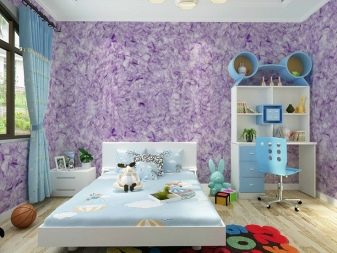
The uniqueness of the cladding lies in the fact that the wallpaper has no joints. Material composition allows the inclusion of the desired color and texture elements. However, it is necessary to add glitters, mother-of-pearl or dyes correctly: an overabundance of additives can complicate pasting, and all the imperfections (uneven or excessive coloring, excessive variegation of gloss) can be visible on the finished surface of the cladding.
Minuses
With all its many advantages, liquid wallpaper has several disadvantages. They:
- are expensive finishes: if you take high-quality raw materials, you need to purchase silk wallpapers, but they are expensive;
- this cladding is afraid of moisture, therefore, it needs a careful attitude and restriction of the use of wallpaper in rooms with the highest degree of risk (kitchen, bathroom, hallway, balcony, loggia);
- the cladding needs the use of a vapor-permeable varnish that preserves the breathability of the wallpaper;
- wallpapers do not have a wide variety of shades: they have to be adjusted, which does not always work;
- dirt on the surface cannot be removed: re-gluing of the problem area is required, and the correction can be noticeable (especially if the composition was supplemented with pigment or glitters).
- it is undesirable to use decoration in an old house with high humidity: the wallpaper can become damp.

Varieties
A distinctive feature of liquid wallpaper is the variety of appearance. Externally, the texture of the coating can resemble embossed paper, hard foam, silk textiles. All varieties can be conventionally divided into:
- cellulose - a material based on paper predominantly (a budget version of liquid wallpaper, characterized by lower indicators of durability and attractiveness of the texture);
- silk - high-quality, expensive and durable raw materials containing silk fibers, resistant to sunlight;
- blended - the golden mean between the first two categories, which is a base from a mix of silk fibers and cellulose.
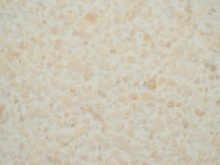
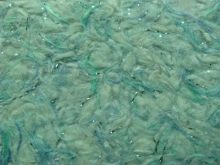
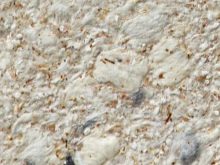
According to the type of release, the material is divided into two categories:
- colored wallpaper, ready for use - two groups of material, some of which are dry (you need to soften), others just open and apply to the walls;
- Varieties for painting - white material without dyes and additional shiny ingredients and decor.
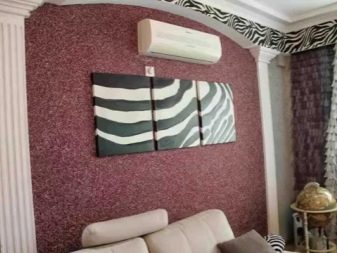
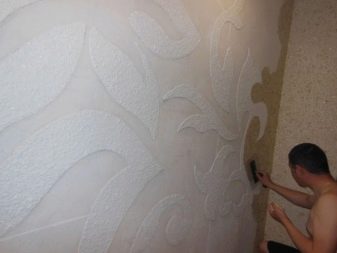
Despite the difference in raw materials, a color composition can be created in different ways. Moreover, both categories provide for this.
In the first case, the drawing can be composed of individual shades, in the second case, the surface is used like a canvas, painting on a white background.
How to work with them?
The technology for working with liquid wallpaper is quite simple, but before the process itself, you need to familiarize yourself with the technique and nuances of finishing. This will allow you to make wall cladding on your own at a professional level, without resorting to the services of experienced craftsmen. It is important to consider a few rules:
- the material is applied to the wall in a uniform layer, using special tools, forming with their help a seamless surface coating without empty areas;
- thanks to the texture, the composition perfectly fills the corners, if necessary, it is possible to trim the wall;
- working with the material requires a respirator if the material is purchased dry: this will protect the respiratory system from hygroscopic particles when mixing the material;
- gloves are not needed in the work: the material is harmless to the skin, but the clothes must be working, as a solution with glue can get on it;
- the rules for preparing the material depend on the specific type of wallpaper, they are indicated on the package;
- the setting of the material is quite long: this allows you to correct the errors in the application of the solution until it dries completely.
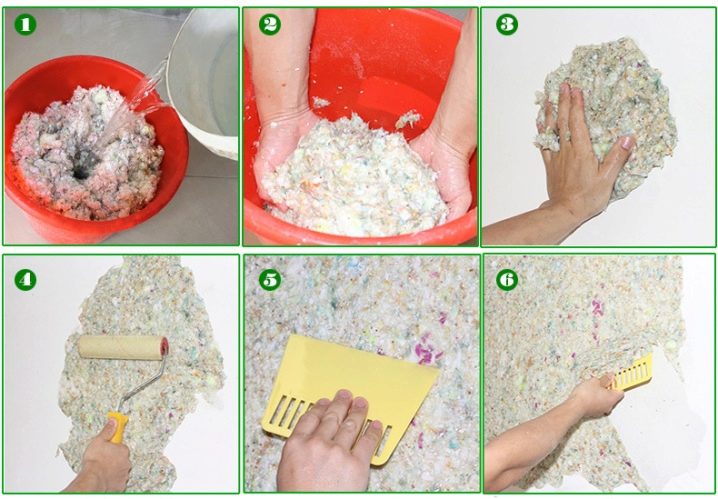
It is important to strictly follow the instructions for preparing the material: if you ignore this fact, the chemicals will not have time to interact, and the structure will be heterogeneous. If the manufacturer's recommendations are followed, the wall decoration will last up to 15 years.
How to apply?
The uniqueness of liquid wallpaper lies in the fact that it can be applied with different tools, the choice of which depends on the degree of density of the diluted wallpaper. To correctly apply them to the wall, you can use the devices that are used to work with plaster, paint, putty. For example, it can be:
- paint roller (with a thin nap for application to the surface, ribbed - to give the desired texture);
- brush;
- large basin (bucket);
- trowel (plastic);
- spatula (metal or plastic);
- gun (hopper).

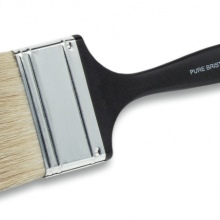
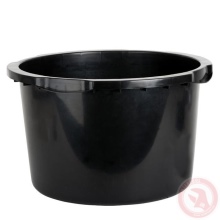
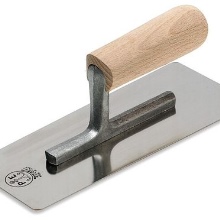

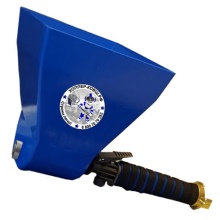
The choice of tool depends, among other things from the area of application. For example, if the wall surface is large, it is more advisable to use a spray gun with a large nozzle when working. If a certain pattern is planned, you can use stencils and add color to the set of necessary items.
Selecting a surface
Liquid wallpaper is not picky about the choice of surface. Different options are suitable for them:
- drywall without putty;
- wooden surface;
- concrete plywood;
- OSB plate;
- penoplex;
- fiberglass.

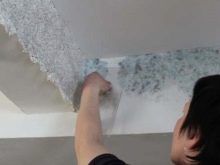
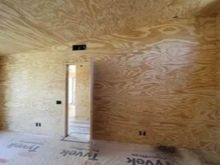
They fit well on:
- paper wallpaper;
- Fiberboard and chipboard;
- plaster and putty;
- cement, brick, stone, shell rock;
- Styrofoam;
- timber (wood).
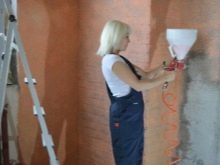
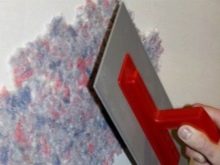
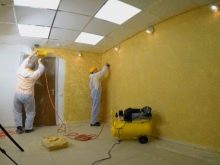
You can not do gluing if on the wall:
- peeling or old paint (oil, water-based, acrylic);
- old whitewash;
- oily or greasy stains.
In all these cases, adhesion decreases.
Sticking to the lining is undesirable: wooden panels have seams, which increases the risk of breaking the integrity of the coating. The same can be said for tiles. Glass simplifies the process of work, although such pasting has a lot of contradictions.
Application methods and technology
The technique of gluing liquid wallpaper depends on the tool used and is different:
- by spraying;
- rolling by means of a roller;
- spreading with a spatula.
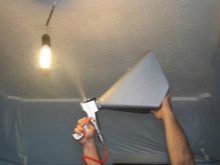

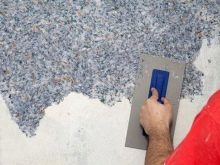
Before the process itself, it is necessary to provide the working area with side lighting: this way beads and streaks are better visible. The first two methods need some experience. A simple master class for pasting with a spatula:
- wallpaper is typed on a tool and applied to the wall from any area or corner, while smoothing the material;
- the spatula is held at a slight angle, while the wallpaper cannot be pressed hard (this deprives the surface of the relief and increases the consumption of raw materials);
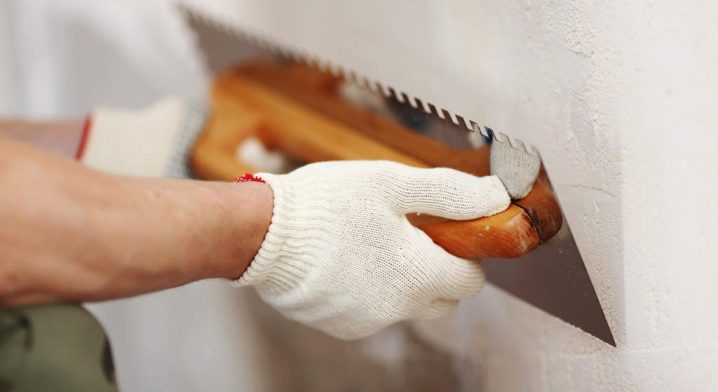
- each new portion is applied from an empty surface to a filled one;
- the layer should not be thin, it is unacceptable for the wall to show through;
- the tool can be moistened with water, otherwise the wallpaper may stick to it, peeling off the wall surface;
- the joints near the baguette or plinth are performed as carefully as possible (it will not be possible to cut off the dried edges carefully);
- to do the docking neatly, you can use masking tape;
- it is important to complete the cladding in one day: as the work continues the next day, the joints will make themselves felt;
- if the joints are visible, you can use water: this makes it easier to smooth out the transitions.
If in the process of work the wallpaper lags behind the walls, it means that the primer was not enough and you need to add a little water to the solution
Preparing the walls
Before gluing liquid wallpaper, you need to prepare the walls painted with the previous material for decoration.Preparing the base with your own hands for work consists of several stages: cleaning the old wall covering, a little sanding of the surface, treatment against fungal plaque and applying primer (it is important to treat the wall with a deep penetration primer). The old cover is removed in order so that the new does not lag behind the surface of the walls (smooth painted surface interferes with good adhesion).
It's great if the surface is rough: this way the wallpaper will hold better. It is necessary to prime the walls before pasting for maximum adhesion of the wallpaper to the wall surface.
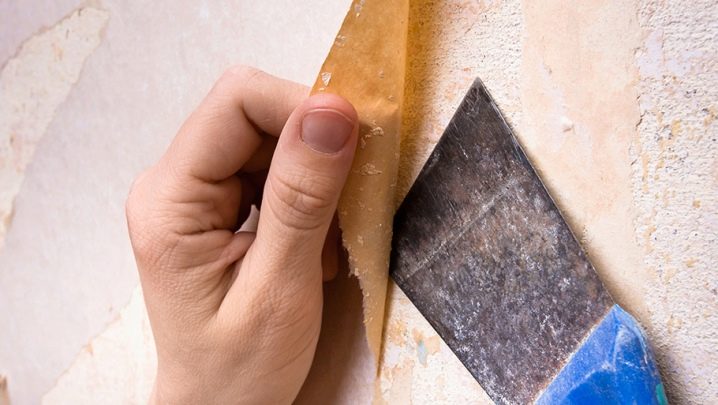
We dilute the glue
If you bought a dry mixture, you will have to soak the wallpaper yourself. It is important to buy a sufficient amount, making the correct calculation: 1 kg of dry mix goes to 4-5 sq. m. wall surface (packaging is enough for about 4 sq. m. with a layer thickness of 2 mm). If you change the proportions and the tool, the material consumption may increase. It is not difficult to dilute the mixture for pasting:
- the bag is shaken to avoid the formation of lumps;
- warm water is poured into the prepared container (the temperature is 30 degrees);
- the powder is poured with simultaneous stirring until the cream is thick;
- stir the mass until smooth with your hands (removing the lumps).

If you need to mix different powders, you need to do this before pouring the mixture into the water. In addition, it is worth remembering that the entire contents of the bag are stirred. This gives a 100% guarantee that the ingredients are mixed in the right amount (otherwise the finish will not last long).
Tinting
If you need to change the shade of the wallpaper, you can mix the wallpaper of different colors or use a color scheme. It is advisable to add dye to the white base mixture: it is easier to get the desired tone this way.
The pigment can be on an organic or artificial basis, it is produced in the form of a paste or a concentrated solution. To choose the desired color scheme, you should pay attention to the composition: it must be compatible with water-borne paints and varnishes, mixtures for whitewashing and plaster. The color of the wallpaper is easier to tint like this:
- the color is dissolved in water for mixing;
- then pour in the dry mixture;
- mix the mass with your hands;
- if shiny additives are planned, they saturate the mass at the very end.
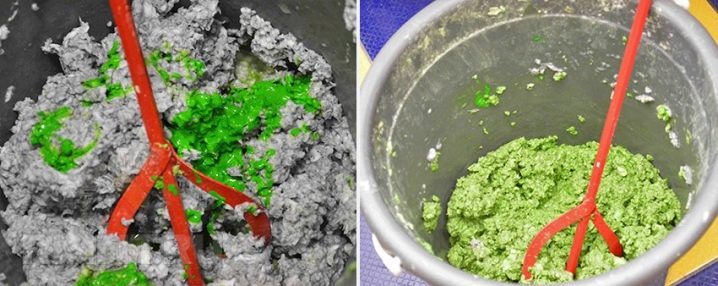
The desired shade is selected in advance, using a little pigment and powder. You cannot add color to the finished mass: this way the coating will be uneven, faded.
How to glue?
There are a lot of design options for finishing with liquid wallpaper. The design depends on the author's idea and the characteristics of a particular room.

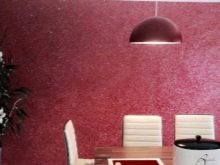
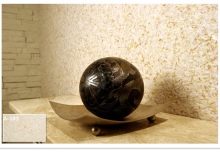
Of course, you can stick them on walls and ceilings. However, the abundance of the same texture negatively affects the overall idea.
It is much more interesting to perform accentuation, paint with wallpaper, make beautiful even stripes, lay out original and abstract ornaments, not forgetting that you need to align the wallpaper with the thickness of the layer.
You can apply the material:
- horizontally;
- vertically;
- Herringbone;
- "Bouquet" (different directions);
- zigzag;
- in a spiral;
- arbitrarily.
You can apply a pattern in the form of squares on the wall, abstract decoration of arches, decorating the semicircular shape of the door ledge with various laces, thematic patterns to match the design idea, or framing the shape with a contrasting shade. It is easier to draw on white wallpaper: this will make the lines smoother and you can more accurately match the color to the existing furnishings.
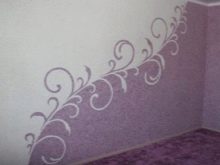

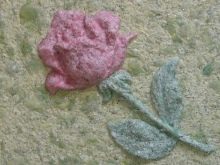
The finish looks good with a textured roller.
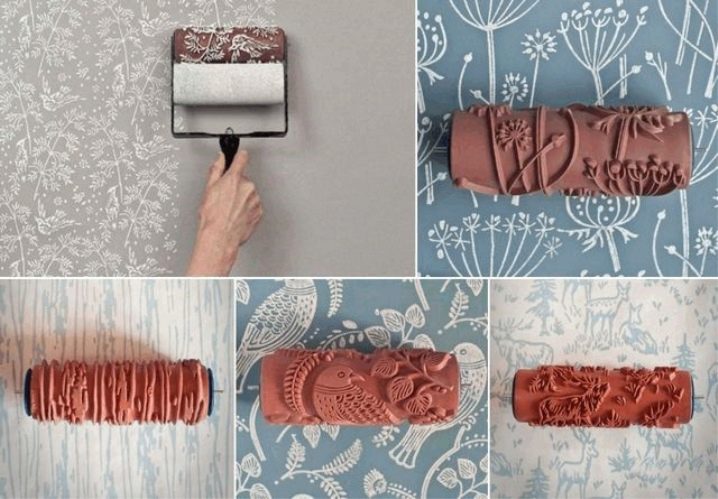
Finishing
Finishing means the final stage of cladding: when the wall is completely covered with wallpaper, it must be sprinkled with water from a spray bottle. This will provide the surface with a uniform roughness. Of course, this stage is not a correction of pasting defects: it does not hide dents, sagging, rough joints. All this is needed eliminate in a timely manner in the process of wall cladding.
It is important to take care of the practicality of the wallpaper by covering it with acrylic varnish in 1 - 2 layers using a roller.Each layer needs to be dried. If glitter is intended, you can add glitter directly to the varnish. Some craftsmen add varnish to the wallpaper itself.
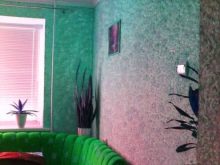
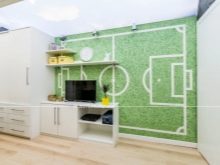
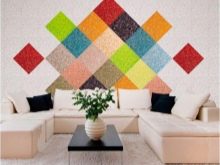
How to glue the ceiling plinth?
Gluing a ceiling plinth is not as difficult as it might seem at first glance: you need a construction knife, a special gun, liquid nails and the plinth itself. To simplify subsequent repairs, glue is applied to the skirting board from the side that is glued to the wall. At the same time, the plinth does not stick to the ceiling, although it sticks tightly. To create even corners, you can use ready-made corner pieces or trim them by placing the plinth on the edge.
Liquid nails are applied to the back side with a construction gun, then the plinth is applied to the intended place and fixed. The glue sets instantly, so the skirting board will hold on tightly.
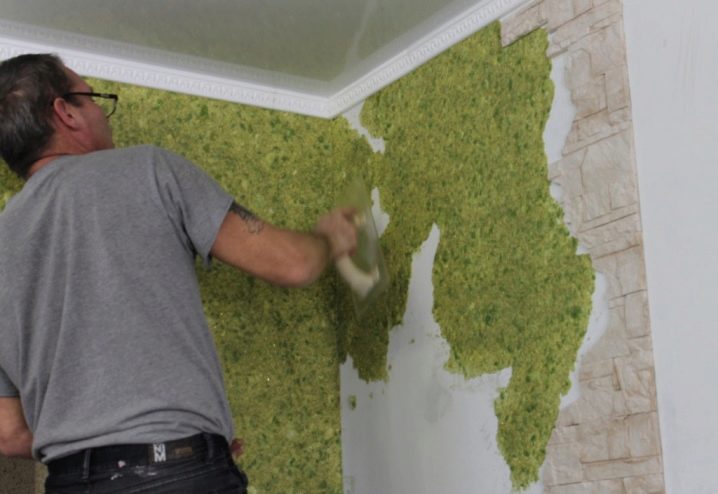
How long does it take to dry?
The degree of drying of the material depends on the temperature in the room, the correct proportions of preparation. On average, liquid wallpaper takes 12 hours to three days to dry completely. If the room has optimal humidity, the layer is small, the consistency is correct, the wallpaper will dry in a day or two.
How to store leftovers?
So that the material can be useful in the future for adjusting the wall covering, you can dry the remaining mass residues. Then they are transferred to a bag, tied tightly and removed until the next repair work. If necessary, it is easy to dilute them with water and restore the desired area. It is important to keep the material neat: if dust and dirt gets in, it is difficult to make accurate adjustments, and the color can become gray due to it.
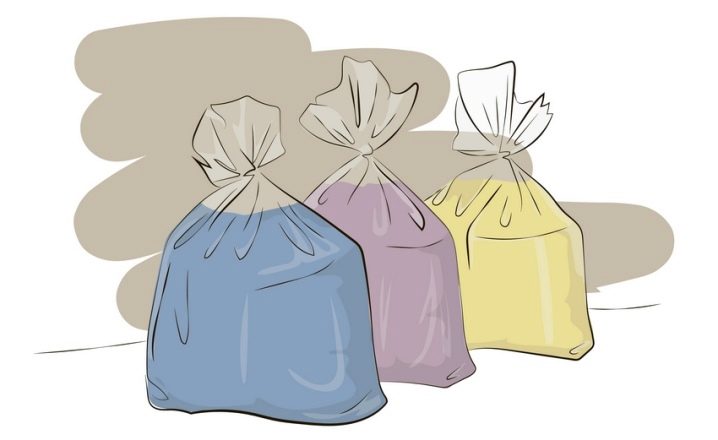
How to repair and upgrade?
If you need to update a problematic area of coverage, you should listen to the mini-instructions:
- the removed surface is moistened with water and soaked;
- the wallpaper is removed with a metal spatula, carefully separating the damaged area;
- the wall is treated with a primer using a brush;
- after the primer has dried, the edges of the wallpaper are sprayed with water;
- using the remnants of the mixture, they are soaked and applied to an empty area, masking the joints;
- after application, the wallpaper is sprayed with water again;
- if the surface was previously treated with varnish, it is applied to the correction area.
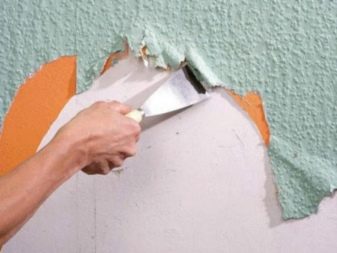
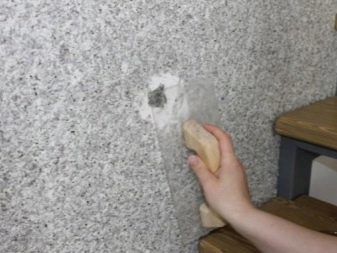
If the area of the glued surface allows you to leave a little mixture, it is better to make sure in advance that the remains are identical, mixed with the bulk. This will make it easier to correct problem areas in the future.
How to care?
Caring for this coating depends on two factors: careful handling and the presence of a topcoat. Some finishes allow the use of a vacuum cleaner, although this procedure, if inaccurately touched, can disrupt the structure of the material. If the surface has not been treated with a special varnish, it is undesirable to touch the wallpaper again. So they can lose their relief. If there is varnish, the wallpaper can be safely wiped with a damp cloth.
Beautiful options in the interior
To update your interior in a special way, stylishly and in the spirit of modernity, you can look at examples of experienced designers who know how to choose the right color and place accents.
Liquid wallpaper can give odds to photo wallpapers: a wall decorated in a marine theme looks colorful.
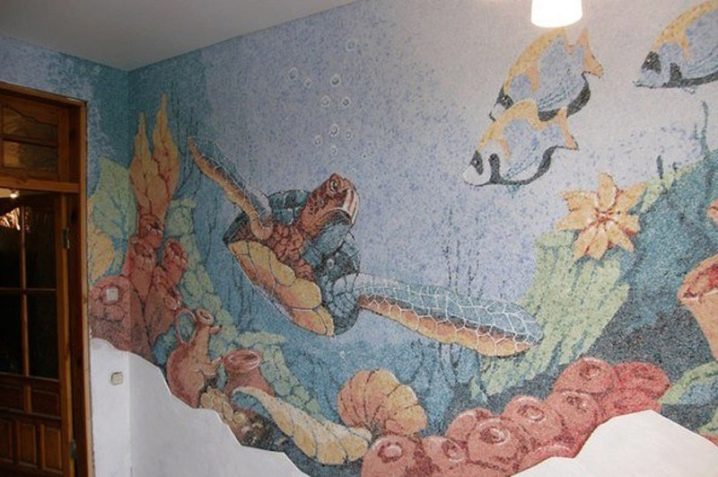
Wallpaper can imitate panels, being placed horizontally along the perimeter of the corridor.

The combination of ready-made brown, beige and white for painting wallpaper allows you to create unique paintings with a play of contrasts: a painting depicting lions looks volumetric and stylish.
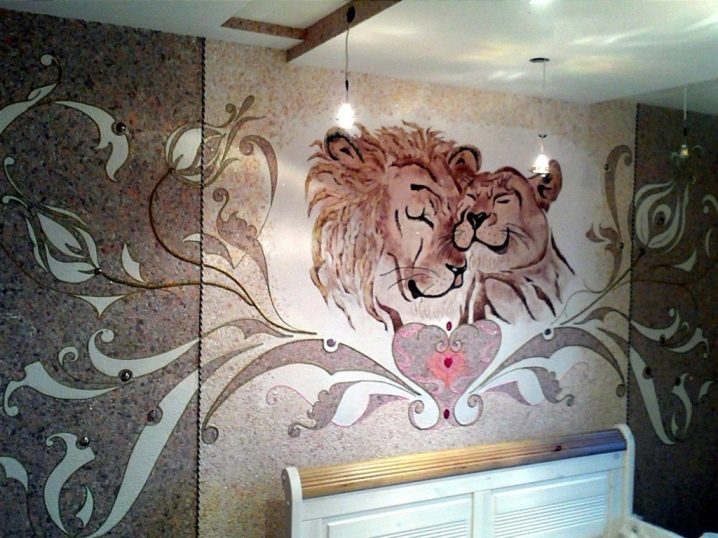
Room design ideas imply a combination of liquid wallpaper with other interior decoration of the apartment. Emerald wallpaper with decorative panels, decorating an accent wall with a mirror, looks solid.
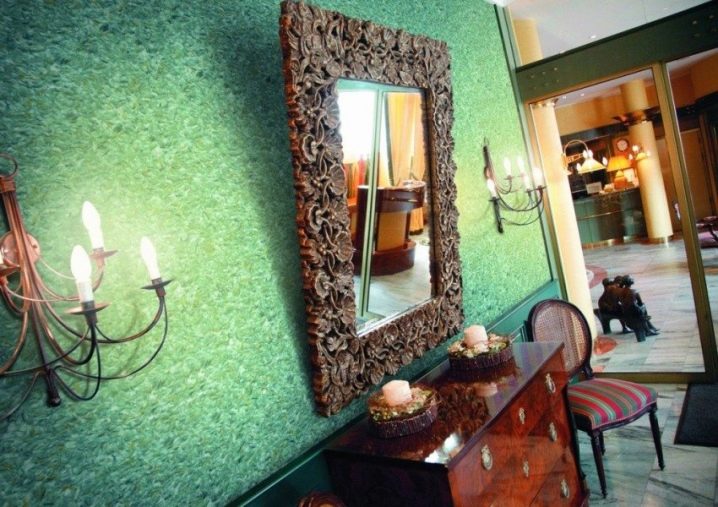
Wallpaper in the bedroom at the head of the bed looks luxurious, combined with paper wallpaper.
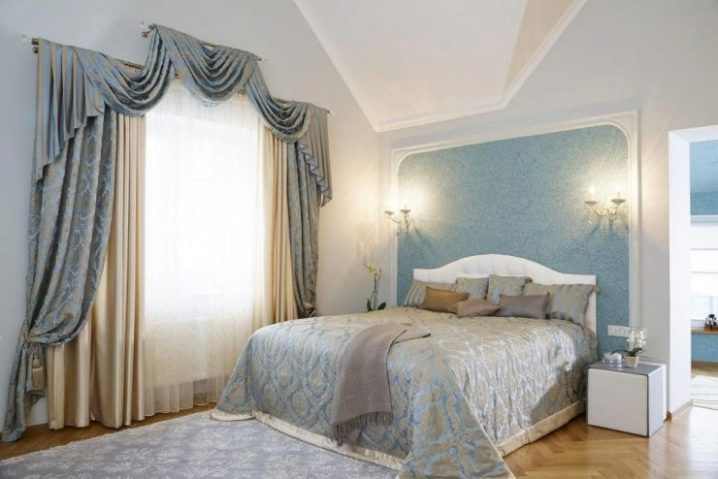
A children's room can be decorated with a contrast of yellow and green, combining shades through a mirror and decorative shelves.

For information on how to choose and apply liquid wallpaper on the wall, see the next video.













The comment was sent successfully.